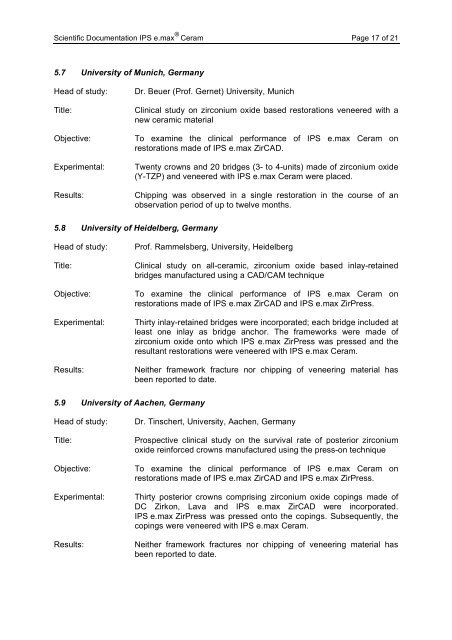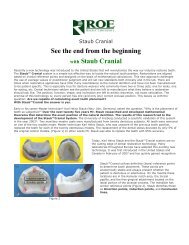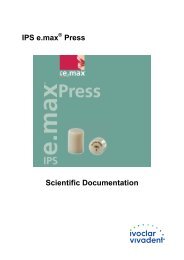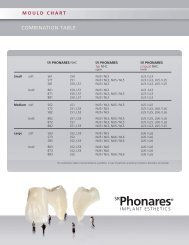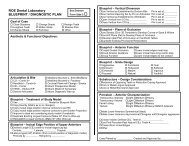IPS e.max Ceram Scientific Documentation - ROE Dental Laboratory
IPS e.max Ceram Scientific Documentation - ROE Dental Laboratory
IPS e.max Ceram Scientific Documentation - ROE Dental Laboratory
You also want an ePaper? Increase the reach of your titles
YUMPU automatically turns print PDFs into web optimized ePapers that Google loves.
<strong>Scientific</strong> <strong>Documentation</strong> <strong>IPS</strong> e.<strong>max</strong> ® <strong>Ceram</strong> Page 17 of 21<br />
5.7 University of Munich, Germany<br />
Head of study: Dr. Beuer (Prof. Gernet) University, Munich<br />
Title: Clinical study on zirconium oxide based restorations veneered with a<br />
new ceramic material<br />
Objective: To examine the clinical performance of <strong>IPS</strong> e.<strong>max</strong> <strong>Ceram</strong> on<br />
restorations made of <strong>IPS</strong> e.<strong>max</strong> ZirCAD.<br />
Experimental: Twenty crowns and 20 bridges (3- to 4-units) made of zirconium oxide<br />
(Y-TZP) and veneered with <strong>IPS</strong> e.<strong>max</strong> <strong>Ceram</strong> were placed.<br />
Results: Chipping was observed in a single restoration in the course of an<br />
observation period of up to twelve months.<br />
5.8 University of Heidelberg, Germany<br />
Head of study: Prof. Rammelsberg, University, Heidelberg<br />
Title: Clinical study on all-ceramic, zirconium oxide based inlay-retained<br />
bridges manufactured using a CAD/CAM technique<br />
Objective: To examine the clinical performance of <strong>IPS</strong> e.<strong>max</strong> <strong>Ceram</strong> on<br />
restorations made of <strong>IPS</strong> e.<strong>max</strong> ZirCAD and <strong>IPS</strong> e.<strong>max</strong> ZirPress.<br />
Experimental: Thirty inlay-retained bridges were incorporated; each bridge included at<br />
least one inlay as bridge anchor. The frameworks were made of<br />
zirconium oxide onto which <strong>IPS</strong> e.<strong>max</strong> ZirPress was pressed and the<br />
resultant restorations were veneered with <strong>IPS</strong> e.<strong>max</strong> <strong>Ceram</strong>.<br />
Results: Neither framework fracture nor chipping of veneering material has<br />
been reported to date.<br />
5.9 University of Aachen, Germany<br />
Head of study: Dr. Tinschert, University, Aachen, Germany<br />
Title: Prospective clinical study on the survival rate of posterior zirconium<br />
oxide reinforced crowns manufactured using the press-on technique<br />
Objective: To examine the clinical performance of <strong>IPS</strong> e.<strong>max</strong> <strong>Ceram</strong> on<br />
restorations made of <strong>IPS</strong> e.<strong>max</strong> ZirCAD and <strong>IPS</strong> e.<strong>max</strong> ZirPress.<br />
Experimental: Thirty posterior crowns comprising zirconium oxide copings made of<br />
DC Zirkon, Lava and <strong>IPS</strong> e.<strong>max</strong> ZirCAD were incorporated.<br />
<strong>IPS</strong> e.<strong>max</strong> ZirPress was pressed onto the copings. Subsequently, the<br />
copings were veneered with <strong>IPS</strong> e.<strong>max</strong> <strong>Ceram</strong>.<br />
Results: Neither framework fractures nor chipping of veneering material has<br />
been reported to date.


